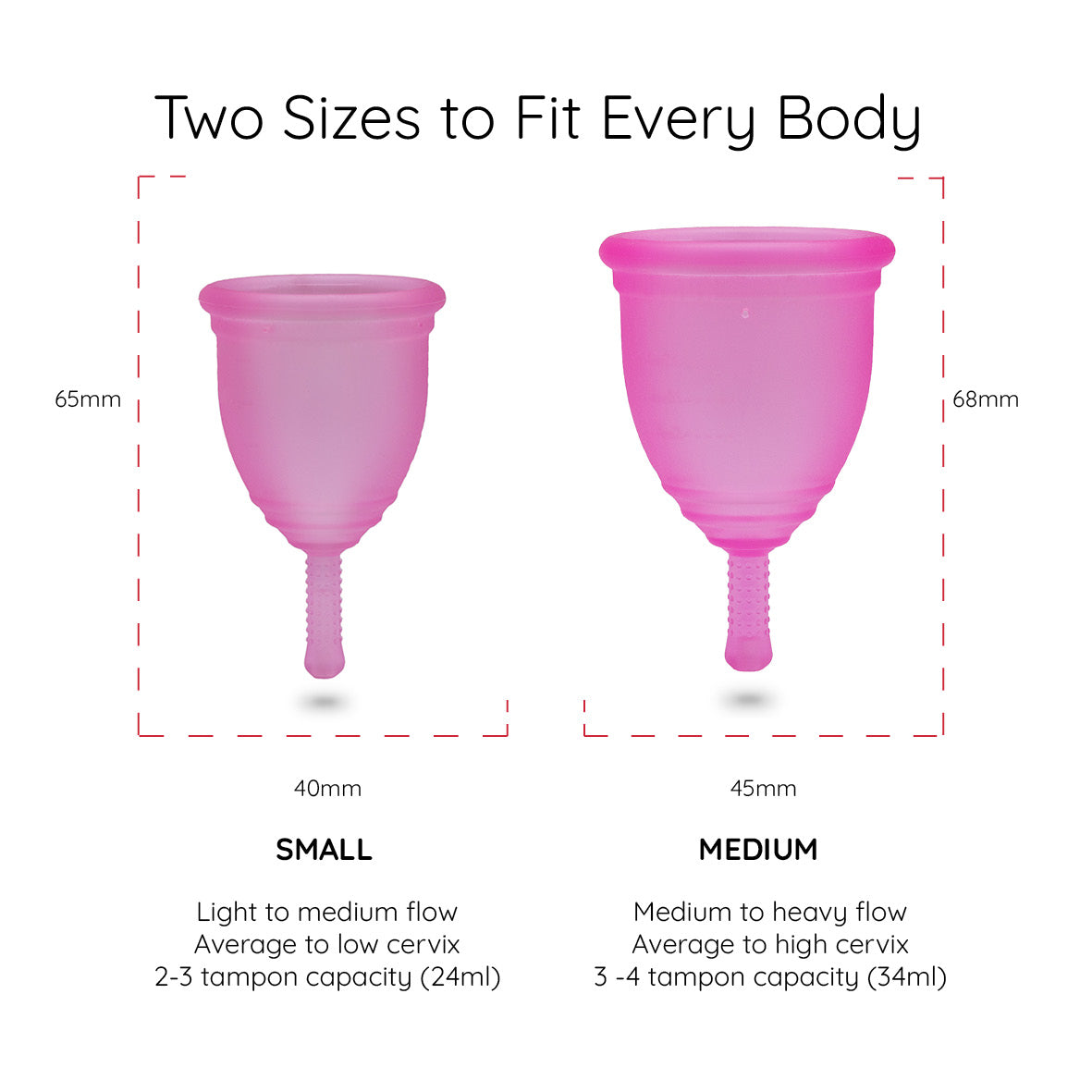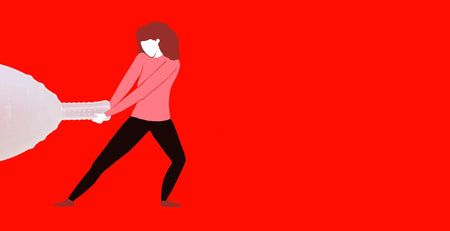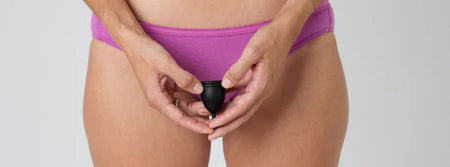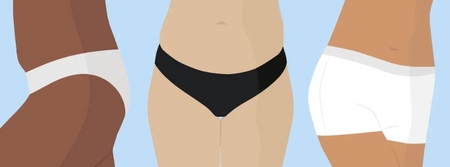To explore these common menstrual cup problems in greater depth, we’ve pulled together this article which will:
- Answer the all-important question "Do menstrual cups leak?"
- Explore the possible causes behind why your menstrual cup is leaking
- Suggest simple ways you can make sure that leaks are a thing of the past
Why does my menstrual cup keep leaking?
In-depth research by the respected medical journal, The Lancet, has found that when it comes to softcup leaking “leakage is similar or lower for menstrual cups than for disposable pads or tampons”.1 So, if your menstrual cup keeps leaking, what are the five common reasons that could explain why?
1. Your menstrual cup is leaking because you're using the wrong cup size
Using a menstrual cup that's too big or too small is one of the most common reasons for leakage.
Are you using the right menstrual cup size? Take our quiz to find out:
If, for example, when you’ve got your period you’re thinking “I can feel my menstrual cup” it may be that you need to use a different cup size – or simply trim the cup’s stem to fit the shape of your body.
“The bigger cup has taken me some time to get use(d) to, and I only use it for my heavy flow day. The Ruby Cup, small size, fits me so perfectly, I tend to forget that I am on periods. I love it.” - Satu
If, after reading our sizing guide, you think you’re using the wrong sized Ruby Cup for your needs after all, just get in touch with us. Our 100% money-back guarantee means we’ll happily exchange your current cup for the different size.
"I ordered a small and a medium, because I wasn't sure what would make the most sense - it turns out it was a good choice. I use both regularly, large on the days with heavy flow because it can go ~5-6hrs, whereas the medium can fill up in ~2 on a gusher day." - MC
Want to change your Ruby Cup for a different size?
2. Your menstrual cup hasn’t popped open to create a full seal
When you insert your Ruby Cup into your vagina, it will ‘pop’ open from its folded position to regain its original shape when it reaches your cervix and create a watertight seal.
If you’re finding that your menstrual cup won't open when it’s inside your vagina, you may need to work your fingers gently around the base of the cup to see if you can help the cup to pop into shape.
A helpful trick to make sure your period cup’s in the right place and fully open is to rotate the cup once you’ve inserted it into your vagina.
By moving your cup slightly from left to right in this way, you can encourage the cup to pop open. Alternatively, you can try gently pushing one side of the cup with your index finger.
If this doesn’t work, simply remove your cup and try again. It may take a few attempts to get it right, and find the menstrual cup placement that works for you, so take your time and experiment with different techniques to find the one that works for you.
How do I know if my menstrual cup is open?
To check that your Ruby Cup is in place and fully open, gently hold onto the cup’s stem and try to pull it downwards. If your cup has opened successfully and created the seal and vacuum you need for it to work, you’ll feel a slight pull.
"I was amazed at how simple it is to use (if you can insert a tampon, then there isn't much difference). After my first period, I felt like a pro (my top tip is to do a couple of squats after inserting and it'll wiggle into place and 'pop' open if it hasn't already) and in fact during over a year of use have only had one occasion where it leaked, due to being half-asleep when I cleaned/inserted it." -Jade
Related post: How to clean a menstrual cup
How do I know if my menstrual cup is sealed?
If it’s inserted properly, your menstrual cup will only move a little way before you’ll feel the pressure of the suction – and it will be very hard to remove without first breaking the seal.
“I have done yoga shoulder stands and vigorous exercise wearing the cup and have not had any leaks. In the early days I did get a couple of very minor leaks due (to) my insertion not being quite right and the cup not fully unfurling but these days I’ve got it sussed and I’ve had no problems.” -B
A helpful tip for successful period cup insertion is to run your finger around the edge of the cup and see if you can feel a crease. If you can feel a crease, this will be what’s preventing the cup from opening fully and creating the vacuum you need. To solve this, try folding your cup in a different way, see our menstrual cup folding guide for more tips on folding your cup.

How do you break the suction on a menstrual cup?
To break the suction on your Ruby Cup and check if it needs to be emptied, the secret is in the pinch.
Unlike a tampon, where you would pull the string to remove the tampon from your vagina, with a menstrual cup, you simply pinch the base of the cup itself to break the seal. Then you can remove your cup and empty its contents into the toilet.
Do you have an IUD or coil fitted?
We know from experience that if your IUD’s strings sit on the rim of your menstrual cup, they can get in the way and prevent the suction you need from forming, which can cause your cup to leak.
If you do use a coil or IUD with your menstrual cup, you can ask your gynecologist to shorten its strings so they can hang directly into your menstrual cup. This will allow the suction you need to form and creates a watertight seal, which means you won’t leak.
“I totally adore Ruby Cups. They have the best fit for the many brands I've tried, being more soft and flexible with a wider circle. It doesn't leak at all and is amazingly comfortable." - Holly
3. Your menstrual cup is leaking because it’s overflowing
If you have a very heavy period, you may be experiencing menstrual cup leaking because your Ruby Cup is overflowing.
That’s because, even though our Medium Ruby Cup has three times the capacity of a super tampon (34ml vs. 10ml), you may lose more blood over a few hours than your cup can hold – and, chances are, your menstrual cup is full.
For this reason, on the days when your flow is very heavy, you might find yourself with a full menstrual cup. On the days when this happens, we recommend that you check your cup to see if it needs to emptying every 4-6 hours.
“I've had the Ruby Cup for some years now and, what a game-changer. I have had heavy clotting and issues using tampons and pads because the clots would cause leaks. At my desk job, just sitting there, I would have panicked, tight-legged, sprints to the restroom. With the Ruby Cup, that doesn't happen!” -Vickie
“Ruby is the 4th cup I’ve tried and my absolute favorite hands down. The only time I had an issue with leaking was on my heaviest day and I had overflown the cup so not even the cups fault.” -Preston
If you find that your cup is overflowing and you’re not already using a Ruby Cup Medium, you might want to consider changing from the Small Ruby Cup to our larger size.

Related Post: The 7 Best Menstrual Cups for Heavy Flow (No Leaks!)
4. Your cervix has shifted, and your cup isn’t in the right position
The human body is a wonderful thing. Did you know that, during menstruation, your levels of estrogen fall, which can cause your cervix to change position?
And that, as you shed your uterine lining and your period starts, your cervix also swells and opens slightly to let the blood flow out more easily?
Not only that, but your vagina may also tilt a little to one side – or even move downwards. Fascinating, isn’t it?
It can also explain why you may be experiencing soft cup leaks or your menstrual cup leaking at night – even though your Ruby Cup isn’t full. This is because your menstrual fluid is flowing down the sides of your cup, instead of into it.
That could be because you’re trying to insert your menstrual cup in the same high position as you would have inserted a tampon, but we’ve found that your cup will work best if it's positioned a little lower down in your vagina and inserted in a horizontal, rather than a vertical, direction – in line with your vaginal passage.
To solve leaks that happen because of this reason, try to place your Ruby Cup below your cervix – and not next to it.
“Of course, it takes a couple of cycles to get used to the procedure but really it's worth it, you just have to hang in there and don't get frustrated with any occurring leaks (it happens the first times, but nothing dire!) If anyone is considering making the switch, you should definitely try it.” -Cassandra Dallou
You can check your menstrual cup placement by running your finger around your cup and feeling if your cervix is outside it. If it is, simply remove your cup and try again. By allowing your Ruby Cup to pop open further down in your vagina, you can reduce the risk of the cup opening next to the cervix instead of below it.
And, if your cup starts to leak a few hours after insertion but you find when you remove it that it’s just half full, this can be because your cervix is sitting inside your cup, displacing the liquid and causing it to overflow.
If this happens, try a lower insertion of your cup – or empty it a little more often while your flow is at its heaviest.

5. Your bowel movements are causing ‘short leaks’
It’s not unusual to be constipated or to have diarrhoea during the first few days of your period, and it can be helpful to know that your bowel movements can also alter your menstrual cup’s position a little too. It’s also useful to know that it’s common to experience a menstrual cup leak when you go to the toilet for a poo.
Unlike tampons, your Ruby Cup won’t fall out—but if your cup is already quite full, the pressure from a bowel movement can cause it to overflow slightly, resulting in a bit of blood showing up on your toilet paper when you wipe.
If this sounds familiar, pairing your cup with a light period panty can be a total game-changer.
Our Fearless Period Panties are designed for those lighter flow days and unexpected leaks—perfect for giving you that extra layer of protection when your cup might shift or spill. They’re breathable, comfy, and absorbent enough to give you peace of mind without the bulk.
Related Post: Tampons vs Menstrual Cups: Which Is the Right Choice for You?
6. You have strong pelvic floor muscles
If you find that your menstrual cup always leaks, it could be that your pelvic floor muscles are very strong. Strong pelvic floor muscles are important and have many positive health benefits – but if you’re thinking, “why is my soft cup leaking?” every time you get your period, it may be because your pelvic floor is squeezing the walls of your menstrual cup. This is the equivalent to you pinching it just before removal.
This muscular ‘pinch’ can cause the seal between your vaginal walls and the rim of the cup to break and allow your period cup to overflow – especially if it’s already quite full.
If this is happening to you, we recommend that you try a menstrual cup that’s a bit firmer.
In terms of firmness, Ruby Cup is in the medium range, which makes it a good ‘all-rounder’ for most people with periods and an easy menstrual cup for first-time users. But if you have powerful pelvic floor muscles and our silicone softcup is leaking for you, you might be better off with a firmer menstrual cup.
There are lots of helpful menstrual cup user groups online where you’ll be able to find information on other, firmer menstrual cups. These firmer cups may be better suited to your body.
FAQs
Why do period cups leak?
There could be various reasons for leaking cups such as:
- Your cup is not the optimal size for you.
- The cup hasn’t popped open or formed the seal.
- Your cup is already full.
But biological factors can also contribute to leaking. Strong pelvic floor muscles can pinch the cup, breaking its seal. Or a bowel movement may push your cup slightly out of place.
Why does my menstrual cup keep leaking at night?
Your menstrual cup may be leaking at night because estrogen levels fall during your menstrual cycle, your cervix swells and shifts, allowing for better blood passage out of the body. Your vagina may also lower and shift as well.
To prevent night leaks, try positioning your cup lower in your vagina, instead of next to your cervix.
What should I do if my menstrual cup is leaking?
If your cup is leaking, make sure your cup is positioned properly and popped open, creating suction. Also, try a different size or firmer cup. If it's a "fake leak'', a mixture of residue blood in your vagina and excess water from a rinsed cup, wipe the vaginal area before and after cup reinsertion. For more details, watch this video.
One final tip on menstrual cups and leaking…
If you notice a leak just after you’ve emptied your menstrual cup, it may be a ‘fake’ or ‘wiping leak’.
Fake leaks can happen during the heavier days of your period, just after you’ve emptied, rinsed and reinserted your menstrual cup. This is because there may be leftover water droplets on the outside of your cup, which can mix with some menstrual fluid from the walls of your vagina during your period cup insertion.
You’ll know if this has happened if you see a smudge in your underwear the next time you go to the toilet.
“I’ve been using my ruby cup for the better part of three years now! I have a generally heavy flow, and love that I don’t need to use the washroom every hour with this. I did have a few leaks in the beginning while getting used to the cup, but nothing that a panty liner couldn’t help with.” -Anna
For extra peace of mind, skip the disposable panty liners and opt for a more sustainable solution. Pairing your cup with our Ruby Cup Period Underwear gives you the perfect backup—designed to keep you feeling secure, comfortable, and totally leak-free. Whether you choose Fearless for lighter days or our Flow Freedom range for heavier flow, you’ll stay protected and confident, all cycle long.
The end of menstrual cup leakage
We hope this guide has been helpful – and that you understand why you may have been experiencing leaks – and how to stop them. The Lancet found that “leakage is similar or lower for menstrual cups than for disposable pads or tampons”.1 which is great news for people with periods who want to save money, protect the environment, and enjoy more freedom while they menstruate.
We want you to enjoy using your Ruby Cup – and to feel safe and protected from leaks at all times. If you’ve been leaking while you’ve been wearing your Ruby Cup – may we suggest that – as a first step – you try a different size?
It’s quick and easy to do. And, with our 100% money-back guarantee, you have the peace of mind that you can exchange your cup within 120 days of purchase.
_________________________________
Reviewed by Dr Alice Byram Bsc Med & Surg UMA MA Hons MML Cantab
Dr Alice Byram was born in England to a French-British family. Following on from a degree in Spanish from the University of Cambridge, she went to Spain to study medicine. On her return to the UK, she worked in Emergency Medicine for several years before recently returning to Barcelona.
1Van Eijk AM, Zulaika G, Lenchner M, et al. Menstrual cup use, leakage, acceptability, safety, and availability: a systematic review and meta-analysis. Lancet Public Health. 2019;4(8):e376–e393. doi:10.1016/S2468-2667(19)30111-2













